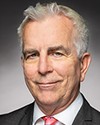Thank you, and thank you, all, for the previous comments. It's an honour to be here.
I bring a different perspective, the lived experience. I am an indigenous man in long-term recovery for 16 years. I'm the creator of pre-treatment housing and peer and culturally supportive indigenous recovery homes. We have long-term, peer-supported transitional homes with no end date.
I'm here to provide my lived experience, along with professionals, with battling homelessness and addiction, which for many of us, including me, means healing. I'm here to provide my thoughts on solving the addiction crisis.
My unresolved childhood trauma eventually led me to the streets, to being homeless for seven years and to my unwillingness to face my demons and my use of alcohol and drugs, including pharmaceutical opioids. This was an emotional response to my childhood trauma, which was so powerful. The shame of being sexually abused is so intense that many men and women lose their lives to addiction or suicide, refusing to speak about it.
We gain knowledge when teaching through words and actions. We heal the same way. The first time I talked about my sexual abuse was while in treatment and doing my steps with a female elder. I cried for two and a half hours telling her about my childhood trauma. I walked out of her room a different man. I had held that childhood trauma for 25 years, and that's what kept feeding my addiction. That kept bringing me back to the same vicious cycle that progressed into what we're dealing with today.
After starting my recovery journey and healing from my childhood trauma, I reconnected with my heritage. It played and plays still a significant part in my healing journey.
I'm going give you a brief, lived experience. I want to tell you a story about a young boy who suffered numerous challenges and trauma in his life, a young boy who grew into a youth who was taught not to show his true emotions, a boy who grew into a young man who had endured so much trauma that he thought he was alone and chose to live a lot of his life just like that—alone.
This young man was a victim of sexual abuse, physical abuse and mental and emotional trauma as well as spiritual trauma. This coping mechanism took the next 20 years of his life. It took his family away. His friends did not want to be around him due to his alcoholism and deceptive tendencies. Eventually, he burned all his bridges and hurt his family so much that everyone gave up on him. He ended up being dropped off at a homeless shelter because nobody could trust him.
This terrified man-child had finally found a place where he was accepted without judgment, without prejudice, and he thought that this was where he belonged, with no self-esteem and no self-worth. This man accepted that this was his destiny.
Living seven years as a homeless, alcoholic addict was what his unresolved trauma led him to, a life with no meaning or purpose, no aspirations or goals, and no love for himself or others. After one of the largest losses in his life at the time, his partner of two and a half years being murdered, he reached a point where he had lost all he was willing to lose due to his addiction and unresolved trauma.
On November 13, 2007, he was arrested for being drunk and disorderly in downtown Calgary. The arresting officers brutally beat him in the back alley. His foot was broken, his eye was swollen shut, and he suffered numerous bruises all over his body. They found that he had 11 warrants for his arrest, so he went to the drunk tank to face the justice of the peace. He had an opportunity to speak with the justice of the peace that morning. He was honest for the first time in his addicted days. He explained that he wanted help, help to deal with his trauma and his addiction issues and help to deal with the murder of his partner.
The justice of the peace asked her name. He responded, Jackie Crazybull. The justice of the peace stated that he had heard about the murder and offered his condolences. He then proceeded to speak with the devastated and defeated man. He said, “I'm going to release you on your own recognizance. I want you to go get the help you so desperately want, and I want you to clean up all these criminal charges.”
That morning, upon his release, this man limped up to medical detox to start his journey towards healing. After almost a full year of treatment and reconnecting to self, culture and community, he made small goals that turned into huge accomplishments. Today, that little boy who suffered all that trauma, that young man who turned to drugs and alcohol as a coping mechanism, that young man who ended up homeless for seven years, turned his life around and is now the executive director of the very same organization that helped save his life.
My name is Earl Thiessen, and I am a wounded healer.
Now I'll move on to the professional part.
As an indigenous leader in Alberta, when it comes to recovery, recovery housing and supporting the continuum of care, I see first-hand the damages of opioid use. In fact, I'm raising my sister-in-law's daughter due to her mom's passing from an overdose.
In my opinion, the way decriminalization and safe supply are being presented is not the path forward. They're making problems worse. They're prolonging trauma and keeping people in a perpetual state of drug use. In my opinion, safe supply is akin to pharmaceutical colonization.
There are other methods, but for the people I serve, the path forward is a recovery-focused path. The biggest thing I can see is that we need more medical detox. Withdrawals are horrible. I experienced them, hit the ground, chewed through my tongue, had two grand mal seizures, then treatment and then recovery. To accomplish long-term recovery, people need all of these, starting with detox and treatment. That's where the pre-treatment housing model came into play due to the wait-list. They need peer support, employment and recovery-focused housing.
There is only one sure way to 100% avoid overdose, and that is not to use. That being said, I fully understand there is a process to go through to get to this point. Saying that one must understand.... Want and need are light years apart. Every person who has an addiction needs to seek help, but it's those who want to seek help who actually can and will recover.
For those who do not want to recover, we need to provide positive reinforcement and show them, through lived experience, success stories that recovery is possible and that they can find recovery. We pray for them. This is all I could do for my sister-in-law. She lost her life.
Many people and organizations focus on the biopsychosocial aspect of trauma and recovery—










